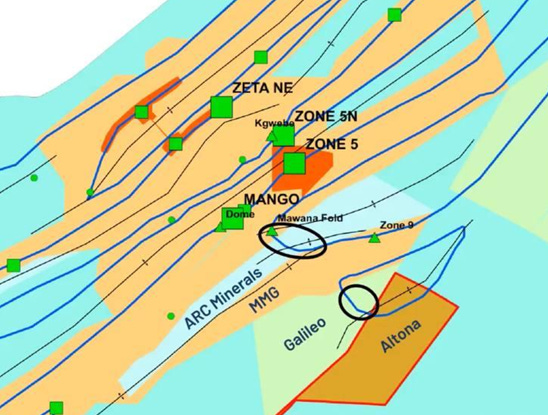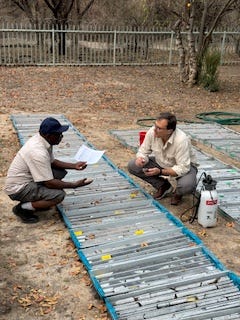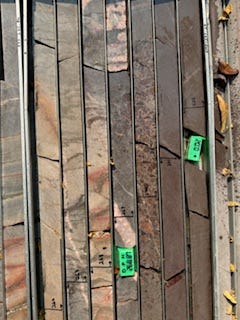
Good morning team. I apologise for the delay in getting this piece out to you.
When you’re investing in exploratory copper plays (and from a geological viewpoint, Arc is in the top tier), there are two investing cases:
the long-term argument ($88.5 million Joint Venture with FTSE 100 major Anglo American to explore some of the most prospective copper tenure in Zambia).
the near term news - of which we should now have plenty.
It’s all very well having a fantastic long-term investment case, but in today’s market, you need regular news to keep the share price (interpretation: investor support) elevated.
The good news is that after a period of relative silence, it’s all about to get cracking.
About time!
If you’re short on time, here’s the tl;dr:
BHP and MMG are both potentially interested in the Virgo licences in Botswana.
Anglo remains a hot takeover target, but the Zambia JV would likely be unaffected in BHP comes aboard.
Drilling at the Botswana licences has generated visible chalcocite, and over half a ton of material has been sent for assay at ALS.
Ivanhoe is entering Zambia, with both Zambia and Botswana now getting rather crowded.
Assays from Zambia may well be ‘in the post.’
Given the recent RNS, I think it’s worth covering Botswana first. At Virgo, within the Kalahari Copperbelt, the first phase of exploration drilling has been completed on PL135/2017 - with eight holes completed covering some 3,023 metres, of which 1,978m were drilled by reverse circulation and 1,045m by core diamond drilling.
562 kilograms of sampled core constituting 309 samples have been sent for assay at ALS in Johannesburg, with results expected within the next few weeks.
For clarity, these samples should now be at the lab and being processed. And 562kg is a significant amount of material to be assayed.
Drilling has now relocated to licence PL162/2017 - and remember, in Botswana, Arc can drill year round. Scout drilling at this licence back in 2022 intersected 3m @ 1.45% Cu and 9.33 g/t Ag. The first phase to this maiden exploration drilling program is expected to comprise approximately six holes, with the possibility of additional holes depending on observations from core resulting from the initial holes.
Chairman Nick von Schirnding enthuses ‘I am very pleased with progress made at our Botswana licence and look forward to providing shareholders with a more comprehensive update once we receive the assay results.’
Yeah Nick, we’re pleased too.
But that’s not the real story is it? Because while you might be pleased, and we might be pleased, there’s another party who is arguably even more Gāoxìng than all of us put together. Remember, the licences are just 10km south east of the massive underground Khoemacau Copper mine.
Now before we dive into that, it’s worth looking at the ownership structure of the Virgo licences; the RNS on 4 November 2021 saw Arc pay £1.2 million in shares to Kopore for 75% of the capital in Alvis-Crest, which at the time held the Virgo licences.
Importantly, Arc has an option to acquire the remaining 25% for $5 million,
‘exercisable until Arc makes a final investment decision, which would be upon the completion of a bankable feasibility study.’
There is also a 1% NSR on the assets capped at $30 million that can be bought for a further $5 million.
The basic point is that Arc can become 100% owners with no royalties on the assets for $10 million - which in the context of mine development is peanuts.
And just look at that positioning, running from zone 9 to zone 5. Imagine instead of mining licences, this was your back garden. You might want that strip back, especially when it’s the one growing the roses.
Please also enjoy some lovely images of the cores…and Arc assessing them!
Remember my words from early August:
‘But the most important takeaway is that there is visible copper mineralisation. This is direct evidence of prospectivity, with visible copper almost always associated with higher grades — and this is the KCB we’re talking about.
Specifically, visible copper was also intersected by Khoemacau within the Mawana Fold Discovery, and we all know how that ended. A natural buyer for Virgo is waiting in the wings.
On initial visible copper finds in Botswana and Zambia — Konkola, Nchanga, Kansanshi, Lumwana, Mulfulira, Chibuluma, Khoemacau, Mowana, Banana Zone and Boseto all started out with visible copper in their assays — and here the subset and superset are valuable. Not all visible copper finds in the region become major copper mines, but almost all major copper mines started out with visible copper in their initial assays.
A particular geological feature worth noting is the presence of ‘chalcocite and bornite blebs’ within carbonate veins and disseminations within the Lower Marl and laminated siltstone.
Chalcocite is arguably the most valuable copper mineral — with a copper content of up to 79.8%, it’s also extremely easy to mine. Bornite is also valuable, with 63% copper on average.
Compare these to the other common copper mineral types; chalcopyrite is the most common, and averages just 34.6% copper. Even malachite only notches 57% — and azurite 55%. Pretty much the only ore that can beat chalcoite is cuprite with an 88.8% purity, but this is rarely found in large quantities, and they're usually smaller than chalcoite deposits.
Khoemacau and Banana Zone both enjoy chalcocite mineralisation among other minerals.
The takeaway is that ARCM has not only got visible mineralisation, it's the best mineralisation you could hope for.’
We’re now already well past the original 3,000 metres planned - and it’s time to consider an asset sale.
Investors have leapt on MMG’s (Khoemacau) interims:
‘Khoemacau regional exploration in the first half of 2024 focused on the Banana Zone corridor and the Zone 5 corridor. At Banana zone, the drilling tested the southwest fold hinge (Chalcocite deposit), targeting three areas higher up stratigraphy that have been delineated from airborne electro magnetic data. These targets are located within the favourable siltstone unit that is higher up stratigraphy away from redox contact, near prominent structural features, and in gaps in conductive units. In the Zone 5 corridor, infill drilling was conducted between existing drill holes for growth (exploration) purpose at the Zone 9 prospect. The drilling focussed on the 1.5km long central portion of the prospect to confirm width and grades of this high-grade area.’
Not only is MMG actively exploring the entire boundary of Arc’s licences, it’s ‘dedicated to completing the construction of an expansion project by 2028, which aims to increase production capacity to 130,000 tonnes of copper. It is expected to reach full capacity by 2029, further contributing to the reduction of C1 costs.’
This more than double present volumes of 60,000; where is the company getting the ore from? It’s investing a further $700 million to make this happen; and remember, it was only back in March that MMG completed the deal to take on Khoemacau from Cuprous Capital for $1.9 billion.
We know that Arc is very close to the Mawana Fold discovery AND that this mineralisation likely extends towards and into Virgo.
So naturally, MMG would be the natural buyer of the Virgo licences, and the meeting at LME this coming week between Arc and the Chinese remains an open secret - however, there is now another potential buyer in the works.
To talk about them though, we next need to jump to Zambia, where we continue to await the Royal Visit.
While that’s on the backburner, it’s worth having a look at what’s going on in-country. Ivanhoe’s founder and Executive Chairman Robert Friedland now enthuses that ‘Over the past 20 years, our geologists have discovered over 50 million tonnes of copper under the western edge of the Central African Copperbelt in the Democratic Republic of the Congo. We are now entering Zambia, as well as Angola, where we have high conviction that new discoveries are waiting to be uncovered.’
The major has signed an MoU with Zambia’s Ministry of Mines and Minerals Development and has applied for an exploration licences package in Zambia, with a decision expected by the end of the year.
The problem - and Ivanhoe knows this - is that whatever crappy licences they’re going after are simply going to be second-rate. All the good ones are gone; FQM, Barrick and Glencore and Vedanta control the big mines, and the juniors snapped up the best exploration tenure long ago.
As an example, Gates-backed KoBold’s discovery at Mingomba could well become world-class, and Kobold has also partnered with Midnight Sun to advance the Dumbwa target within Midnight Sun’s Solwezi project. For reference, Midnight Sun is also partnered with FQM.
On that topic, I’d argue that Midnight Sun’s exploration licences are almost as valuable as Arc’s - and they also had a spot of bother with the Cadastre, but all is now well. They were also hit by a falling share price as a result - and this should now start to recover.
Of course, Arc shareholders are currently tied to Anglo; and I have seen evidence that pressure is currently being applied by its own shareholders to see increased activity in-country.
But Wanblad is not having an easy time of things; he wants to sell the nickel, coal, De Beers diamonds, and platinum businesses within two years, leaving the white elephant in Yorkshire, some iron, and the copper on the books. But the collapsing prices of these materials (and a pesky fire in the Queensland coal mine) haven’t helped.
However, at some point soon, there will basically just be the iron and copper left - and Anglo will then become even more attractive to BHP. The question, of course, is whether the larger major will make another bid beyond its latest £39 billion offer when takeover restrictions are removed at the end of November.
Anglo has enjoyed something of a recovery this month in keeping with the copper price, but is still only playing with a £32 billion market cap, so remains a target - and other majors could come out to bat.
Meanwhile, BHP remains overwhelmingly dependent on Chinese demand for iron ore, and yes China has played ball with its economy once more, but the previous irone ore headline panic has only served as a reminder of BHP’s Achilles heel.
BHP also arguably has the very weakest copper growth trajectory of all major peers, and is looking keenly at Africa for its next copper discovery. For example, it recently executed a Letter of Intent with Cobre for the potential Tier 1 Kitlanya West and East copper projects on the Kalahari copper belt in Botswana after the initial Xplor grant last year.
Hang on, where are Kitlanya West and East? Find a map and draw your own conclusions!
And BHP will almost certainly make another attempt for Anglo, especially if the company has already structured sales for the less profitable divisions (even if selling off De Beers in a weak part of the cycle is an error).
Of course, when it comes to the Zambian licences, it’s likely all will continue as before if BHP does end up swallowing Anglo - BHP is hungrily searching for copper, and the major already knows the licences intimately given they inspected the site visually in the years when Arc was selecting a JV partner.
But given the Cobre news, there’s also a very good chance that BHP will want to consolidate - and the Virgo licences constitute prime tenure.
There’s of course another piece of the puzzle; Kavango’s Botswana licences in the same vicinity - along strike from MMG’s Khoemacau and Sandfire’s Motheo. You could see BHP making an offer of some kind for these as well.
But for Arc shareholders, I do think you may see some serious offers for Botswana, especially if the assays come back as peachy as expected.
In terms of what next, we are going to see an explosive period of news as operations in both countries start to report back - this is great for getting the share price to recover, but is sub-optimal compared to spread out RNS releases.
Botswana assays will come within the next two weeks or so - meanwhile, similar core data from Zambia may be forthcoming shortly.
Licence issues are on the verge of a resolution, and LML news should be close, which will cement Arc’s position. Then there’s the Royal Visit…
But what investors really want to see is returns: a clean sale of the Botswana licences to MMG, BHP, Sandfire or whoever for several tens of millions of dollars.
Stick a few quid in the bank for a rainy day, buy a couple more licences for round three, and then issue a special dividend.
Have a great week.






